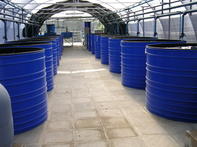
Essential Aspects of Fish Farming
Three aspects are essential before commencing with such an aquaculture venture. A new fish farmer will need: A business plan A construction design An operating plan Unfortunately, this planning information is often sourced from people or sources that provide outdated or inaccurate information and data.
Countless times well-meaning promotional organisations repeat the errors of the 1960’s aquaculture failures. And new projects fail again.
All over Africa, we find small ponds, filled with clear, shallow water, totally over-stocked with mongrel fingerlings of unknown ancestry. Feeding of fish in these systems is usually minimal, management is almost non-existent and by the time the projects fail, the advising organisation is long gone.
Private Sector
The development of rural aquaculture requires a strong commitment by the government and other promotional agencies to utilise the skills of the appropriate private sector. The private sector can help with the drawing up of business plans, farm designs and for the training of new fish farmers.
Viable fish farming exists and is used in countries like China, Thailand, Indonesia, Bangladesh and increasingly in rural South and Central America. These successful fish farms use fertilised and fed earth ponds.
These earth ponds have the advantages that are essential to rural fish farming success: lower risk, less energy dependence, lower skills demand and high productivity, producing up to 18 tons of fish per hectare. This fish farming system has an easily copied track record that can be followed and duplicated in South Africa.
The aquaculture designs are simple but clever and not primitive in any way. Strict attention has to be placed on actual pond design and construction of these earth ponds, water quality control, stocking and fertilisation of the water, to allow for the growth of natural fish food. Information on commercial pond fish farming is also readily available.
Training of New Fish Farmers
It is proposed that the promotion of rural aquaculture be focused on the funding of private sector demonstration and training facilities for fish farming. These facilities should not be high tech, complicated systems.
Training facilities for new fish farmers should not be in areas far from the needs of the rural communities or in climates far removed from the warm climate required. Rather, the demonstration facilities could be situated right where the demand is, in the low altitude rural community areas.
These demonstration facilities should be identical to those that rural communities will need to build to achieve success in their own projects.
Business plans based on such successful ventures will more easily raise capital than those that attempt to secure funds based on complicated and often inappropriate Recirculating Aquaculture Systems (RAS) technology, often still at the research and development stage, with no current visible track record of success.
The successful fish farming stories are out there, frequently in Asia, but increasingly now also in Africa, particularly in Zambia. We need to copy them.
By Nicholas James